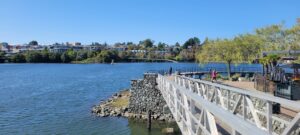If you’ve ever taken a stroll along the southern end of the Gorge or near Bamfield Park in Vic West, you’ll likely have noticed a long trestle bridge that connects the Burnside area with downtown. UVic adjunct professor Frank Leonard will be giving a talk later this month about the history of this project, and the often comic, sometimes tragic, downfall of a doomed project that never had much hope of survival.
Leonard’s talk is titled “The Other Railway Terminal: Early Development of the Canadian Northern Pacific/Canadian National Yard on the Former Songhees Reserve, 1909-1928,” and the idea for it all started when Leonard, after walking along the old Selkirk trestle, started to wonder what this thing was for and why it was there.

“What I discovered is that there was a railyard there, and it was much larger than the E&N railway, which of course everybody knows about,” says Leonard.
The E&N railyard is now the Roundhouse in Esquimalt, which has been under debate and development for many years. But what this talk is all about is the other railyard, which is non-existent today, with almost no remnants proving that it ever existed at all. Unfortunately, there is scant information in Victoria—or online, for that matter—regarding this massive railyard.
“It was a matter of just wrestling with what was here and in both the provincial and city archives,” says Leonard. “Then I got really frustrated and started to talk to my friends in Ottawa at the national archives.”
While there are colonial considerations to how the railyard would come to be on the Songhees reserve, this particular talk starts after the reserve was surrendered.
“All of the stuff for this railway was done after the Songhees Reserve was surrendered. That happened in 1911, and this really gets started after 1911,” says Leonard.
The talk will highlight economic and political considerations: basically, the project was doomed to fail with no hope of any real success.
“The railway yard is at one end, and when it was planned it was thought that there would be two entrances: one in the south and one in the north,” says Leonard. “But the southern entrance never happened because of the CPR going from east-west onto the Songhees reserve… They only had one entrance, and the entrance is the trestle.”
The rail company’s determination to extract Vancouver Island’s timber knew no bounds as they found clever ways of losing money. Despite their grandiose ambitions, the CN Rail company ended up with one small yard with one track in Victoria.
“They were going to have 20 tracks and ultimately would have… seven miles of tracks, 20 tracks for this thing,” says Leonard. “It was going to be really impressive, [but] all the trains that came in had to back out across the trestle to a Y, which is a set of triangles to turn around, and that Y is beside Uptown today.”
The Other Railway Terminal: The Early Development of the Canadian Northern Pacific/Canadian National Yard on the Former Songhees Reserve, 1909-1928
7:30 pm Thursday, September 26
James Bay New Horizons Centre
victoriahistoricalsociety.bc.ca
